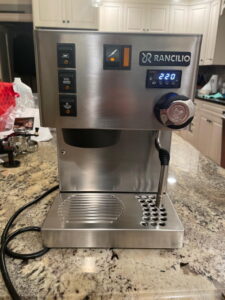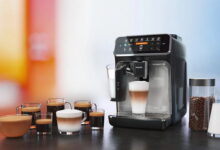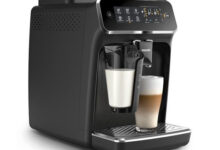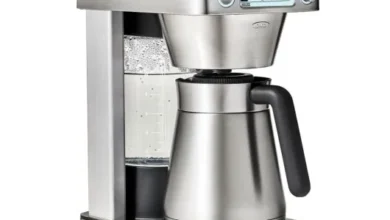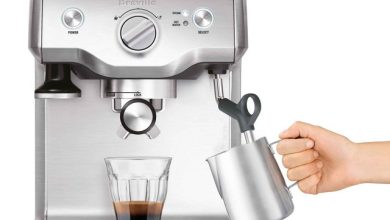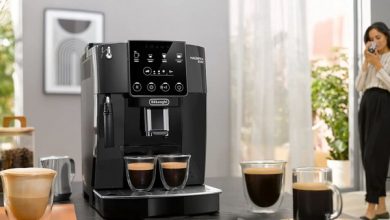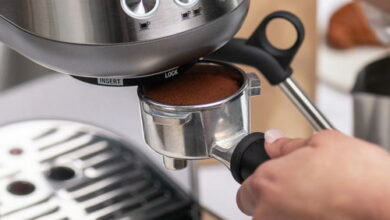The Rancilio Silvia has long been a favorite among espresso enthusiasts, known for its robust design and exceptional brewing capabilities. Upgrading to a PID controller significantly enhances the machine’s temperature stability and overall performance, allowing the user to achieve consistent brew quality. This modification not only transforms the brewing experience but also opens the door to advanced Espresso-making techniques.
As coffee aficionados explore the benefits of a Rancilio Silvia equipped with a PID, they gain the ability to precisely control temperature fluctuations that can impact flavor extraction. This transformation paves the way for crafting perfect shots, providing greater satisfaction in every cup.
With a range of retrofit options available, users can find kits that suit their specific models, ensuring compatibility and ease of installation. Embracing this upgrade allows coffee lovers to elevate their home brewing to a whole new level, combining functionality with the joy of coffee craftsmanship.
Key Takeaways
- Upgrading to a PID controller improves temperature stability for better espresso.
- Proper installation and calibration can maximize the machine’s performance.
- User experiences highlight the significant differences in brewing consistency after modification.
Understanding PID Controllers
PID controllers are essential components in precision temperature management for various applications, including espresso machines. They enhance the consistency and quality of brewed coffee by regulating temperature fluctuations with great accuracy.
Basics of PID Control
A PID controller stands for Proportional, Integral, and Derivative control. Each component plays a critical role:
- Proportional: This part responds to the current error, adjusting the output to the difference between the desired set point and the measured process variable, such as temperature.
- Integral: It accumulates past errors, addressing any persistent offset by adjusting the control output over time to eliminate steady-state errors.
- Derivative: This element predicts future errors based on the rate of change, allowing the system to respond more effectively to sudden changes.
Together, these components work in harmony to maintain optimal conditions, particularly crucial in brewing espresso.
Benefits of a PID on an Espresso Machine
Integrating a PID controller into the Rancilio Silvia can significantly enhance espresso consistency. Temperature stability is vital for extracting flavors correctly.
- Precision: With a PID, the user can set a specific brewing temperature, which can be maintained within ±1 degree. This precise control eliminates the guesswork associated with traditional thermostat systems.
- Consistency: Consistent brew temperatures lead to uniform extraction, which improves the overall flavor profile in the cup.
- Adaptability: Users can fine-tune their brewing settings depending on specific coffee types, enhancing the versatility of the machine.
Incorporating a PID controller transforms the Rancilio Silvia into a more capable tool for coffee enthusiasts looking for the perfect shot.
Rancilio Silvia: Before and After PID
The Rancilio Silvia has been a favorite among espresso enthusiasts for years. The addition of a PID controller significantly alters the machine’s consistency and overall performance, enhancing the espresso-making experience.
Espresso Quality Without PID
Before the installation of a PID, the Rancilio Silvia relies heavily on traditional temperature control methods. This often leads to temperature fluctuations during brewing.
Inconsistent temperature can affect the extraction quality of espresso shots. Typically, temperatures may drop significantly during shot pulls, leading to under-extraction. This results in sour or weak flavors.
Baristas often resort to techniques such as temperature surfing, trying to manually gauge optimal brewing temperatures. This process can be tedious and unpredictable, making it challenging to achieve perfect espresso shots.
Improvements with PID Installation
Installing a PID controller on the Rancilio Silvia offers precise temperature management. This advancement allows users to set and maintain a stable brew temperature, drastically reducing the risk of fluctuations.
With a PID, baristas can achieve an optimal brewing temperature, usually around 200°F (93°C). This consistency helps in extracting flavors more effectively and producing richer, balanced espresso shots.
The PID also allows for features such as pre-infusion settings and shot timing adjustments. These enhancements provide users with the tools needed to tailor their espresso-making process, leading to a more satisfying cup.
In short, the PID installation transforms the Rancilio Silvia into a more reliable machine for crafting exceptional espresso.
Choosing a PID Kit for Rancilio Silvia
Selecting the right PID kit for the Rancilio Silvia can significantly enhance the performance of the espresso machine. Key features to consider include ease of installation, reliability, and temperature control capabilities.
Best PID Upgrade Options
Some of the top PID kits for the Rancilio Silvia include brands like Auber Instruments and Brewtus. The Auber PID kit is popular for its user-friendly installation process and precise temperature control.
Another solid option is the Inkbird PID controller, known for its digital display and consistent performance. Each of these kits offers distinct features, such as programmable settings and self-tuning capabilities, which help achieve the perfect espresso shot.
Installing a PID upgrade can void the warranty, so careful consideration is essential. Users often report increased temperature stability and improved extraction quality after installing these kits.
What to Look for in a PID Kit
When choosing a PID kit, there are several critical factors to assess. First, consider the installation process. Look for kits that come with clear instructions and all necessary parts.
Next, evaluate the temperature accuracy. A controller that offers precise adjustments can make a noticeable difference in extraction quality.
Also, examine the build quality and customer support associated with the kit. Reliable manufacturers typically provide robust customer service, which can help troubleshoot installation or operational issues.
Finally, check for compatibility with the Rancilio Silvia. Each kit should clearly specify its suitability for this model, ensuring a smooth upgrade experience.
Installation Guide
Installing the PID controller on a Rancilio Silvia espresso machine enhances temperature stability and improves brewing consistency. This section outlines the necessary preparations and provides a step-by-step installation process for optimal results.
Preparing for Installation
Before beginning the installation, it is crucial to gather the necessary tools and materials. This typically includes the PID controller kit, a screwdriver set, and electrical wire connections. It may also be helpful to have a multimeter on hand for testing.
Next, ensure that the Rancilio Silvia is unplugged and that there is adequate workspace. Reviewing the specific installation manual can provide valuable insights into the process.
A safety check is essential. Make certain that all components are in good condition and that no wires are exposed to minimize risks. Finally, having a clean, organized area will help in efficiently performing the installation.
Step-by-Step Installation Process
- Remove the Top Cover: Using a screwdriver, remove the screws securing the top cover of the Rancilio Silvia. This will provide access to the internal components.
- Identify Wiring: Locate the thermal sensor and existing thermostat. Proper identification of these components is crucial for effective installation.
- Connect the PID Controller: Following the installation guide, connect the PID controller to the previously identified components. Ensure that all connections are secure and well-insulated.
- Mount the Controller: Position the PID controller in a suitable location on the machine’s exterior, ensuring it is easily accessible for adjustments.
- Testing: Once connections are made, plug in the machine and perform a test run. Verify that the PID controller is functioning correctly by monitoring temperature stability.
Following these steps will ensure a successful installation of the PID controller on the Rancilio Silvia espresso machine, leading to enhanced brewing performance.
Programming and Calibration
Programming and calibration are essential for maximizing the performance of the Rancilio Silvia PID. Proper setup ensures consistent espresso shots by maintaining precise temperature control.
Initial PID Setup
To begin with the Rancilio Silvia PID programming, access the PID controller’s settings. This typically involves pressing the “Menu” button on the Auber PID and navigating through the display.
Key parameters to set include:
- Set Value (SV): Desired temperature (usually between 200°F and 205°F).
- Proportional Band (P): Controls heat output – lower values give faster temperature responses.
- Integral Time (I): Balances temperature stability over time.
- Derivative Time (D): Reduces overshoot when reaching the set temperature.
Adjust each parameter incrementally, allowing the machine to stabilize after each change. Monitoring temperature stability during this phase is crucial for achieving optimal espresso extraction.
Calibration for Optimal Temperature
Calibrating the Rancilio Silvia PID controller ensures the brew temperature consistently aligns with the set value. To do this, monitor the actual temperature displayed by the PID unit against a reliable thermometer.
Steps to calibrate:
- Measure the Water Temperature: Use a thermometer placed in the brew head.
- Compare Readings: If the temperature deviates from the SV, recalibrate accordingly.
- Adjust PID Settings: Fine-tune the SV based on real-time measurements.
For precise calibration, it’s important to adjust the diffusion time and factor in any thermal lag. Regular calibration helps maintain consistent brewing quality by ensuring that temperature variations do not affect coffee extraction negatively.
Operational Tips and Maintenance
Proper operation and maintenance of the Rancilio Silvia PID are essential for optimal performance and longevity. Focusing on daily adjustments and routine care ensures consistent espresso quality and minimizes potential issues.
Daily Use and Adjustments
Before starting the day, ensure the machine has warmed up for 25 to 45 minutes to stabilize the brew water temperature. An empty portafilter should be installed to help heat the group head during this period.
Users should monitor the set value (SV) on the PID controller. Pulling shots at temperatures within ±1 degree of the set point yields the best results. Adjustments to the temperature may be made depending on the coffee being used, but do this gradually to avoid drastic changes.
Regularly check the brew pressure using a gauge if available, aiming for a reading around 9 bars for optimal espresso extraction.
Routine Maintenance
To maintain the Rancilio Silvia PID system effectively, daily cleaning is necessary. After each use, flush the group head by running water through it without coffee, ensuring any residual oils are removed.
Every week, users should perform a more thorough cleaning by soaking the portafilter and baskets in a solution designed for espresso machines. Monthly descaling is also recommended, especially in areas with hard water, to prevent scale buildup in the boiler.
Refer to the Rancilio Silvia PID User Manual for detailed instructions on specific maintenance tasks. Regular inspections of electrical connections and ensuring the water reservoir is clean will help maintain optimal function.
Troubleshooting Common PID Issues
When using a Rancilio Silvia with a PID controller, encountering issues can be frustrating. Understanding how to identify symptoms of malfunction and knowing how to resolve these common problems can enhance the machine’s performance and longevity.
Identifying Symptoms of Malfunction
Several symptoms can indicate problems with the PID unit on a Rancilio Silvia. Common signs include inconsistent water temperatures during extraction, where fluctuations might occur despite the PID setting.
Heater cycling issues may also arise, causing the element to turn on and off too frequently. Users might notice slow or erratic pump engagement, meaning pressing buttons does not always yield expected results.
In some cases, an error code on the PID display suggests specific malfunctions. Physical inspection for loose connections, burnt wires, or damaged components is necessary.
How to Resolve Common Problems
To resolve PID issues effectively, the first step is to check all electrical connections. Loose wires can lead to erratic behavior. Ensure the thermocouple is in good condition and properly connected, as misalignment can cause incorrect temperature readings.
If the PID controller is unresponsive, a reset may help. Power down the unit, wait for a few moments, and then restart it. Frequent cycling of the heating element might require reprogramming the PID settings.
Refer to the Rancilio Silvia PID installation guide for troubleshooting specific errors. If persistent issues occur, professional service may be necessary to diagnose deeper mechanical problems.
Cost and Value Consideration
Investing in a Rancilio Silvia PID upgrade involves various cost factors and potential returns that users should carefully evaluate. Understanding the breakdown of upgrade costs and assessing the return on investment will help determine if this enhancement is worthwhile.
Breakdown of Upgrade Costs
The total cost of adding a PID controller to a Rancilio Silvia typically includes several components. The Rancilio Silvia itself can be priced around $735 (~605€) for a stock model. The addition of a PID kit from Auber costs approximately $159.50 (~130€).
If users choose to install the PID themselves, there are no labor costs, which can lead to significant savings. The estimated total for a stock machine with a standard PID kit is around $895. For those looking for more advanced options, such as a wifi-enabled PID setup, additional costs may arise from purchasing extra components like a Raspberry Pi.
Assessing the Return on Investment
Evaluating whether the Rancilio Silvia PID upgrade is worth the investment hinges on several factors. One primary consideration is the enhanced brewing consistency it provides. With better temperature control, users may find improved coffee extraction, resulting in better-tasting espresso.
Many users report that after installing a PID, their coffee quality improves significantly, which may justify the initial cost. Additionally, the upgraded machine may retain higher resale value as it possesses desirable features for potential buyers. Given the costs involved with the upgrade, users should weigh their coffee preferences and experience against the expenditure to determine if it aligns with their needs.
User Experiences and Reviews
Feedback on the Rancilio Silvia with PID highlights its performance and reliability. Users consistently mention the machine’s ability to maintain stable temperatures, which significantly enhances the espresso-making experience. Below are insights from both customers and professional baristas.
Customer Testimonials
Many customers have shared positive experiences after installing a PID kit on their Rancilio Silvia. One user noted that temperature stability improved extraction quality, resulting in richer flavors. They specifically appreciated the ease of installation of the PID kit. Another user highlighted that the machine has turned brewing into a more predictable and satisfying process.
Some users were initially concerned about the adjustment period, but most agree that the benefits are worth it. As one reviewer stated, “Once you understand the PID controls, the Silvia becomes a powerful espresso machine.” Customers often regard it as an excellent entry point for home baristas seeking professional results.
Professional Barista Opinions
Professional baristas also recognize the advantages of upgrading the Rancilio Silvia with a PID system. A well-known barista noted that the PID’s precision allows for accurate temperature management, leading to higher extraction yields. This has been confirmed by many who measure their brew results, with reports of extraction rates around 18.9%, which is commendable.
Another barista highlighted the machine’s build quality and reliability. With regular maintenance, the Rancilio Silvia can compete with more expensive models, especially when equipped with a PID. Baristas often emphasize that these upgrades elevate the Silvia, making it suitable for both enthusiasts and professionals who value consistency in every cup.
Comparative Analysis
When evaluating the Rancilio Silvia PID, it’s essential to consider how it stands against other espresso machines. This comparison can provide insights into its performance, features, and value.
Rancilio Silvia PID vs. Other Brands
The Rancilio Silvia PID is often compared to machines like the Breville Dual Boiler. While both are popular in the home espresso market, they cater to slightly different users.
The Rancilio Silvia PID offers precise temperature control through its PID controller, allowing for consistent brewing conditions. Conversely, the Breville Dual Boiler excels in user-friendliness and offers dual boiler functionality, which enables simultaneous brewing and steaming.
Key Features Comparison:
| Feature | Rancilio Silvia PID | Breville Dual Boiler |
| Temperature Control | PID Controller | Dual Boiler |
| Build Quality | Durable, heavy metal | Stainless steel design |
| User Experience | Requires more skill | User-friendly interface |
This detailed comparison reflects the distinct advantages and drawbacks that might suit different preferences.
PID vs. Non-PID Models Comparison
When contrasting PID and non-PID models of the Rancilio Silvia, the differences in brewing experience are significant. The PID model allows users to set specific temperature preferences, leading to better flavor extraction.
In contrast, non-PID models typically rely on traditional temperature surfing, which requires skill and experience. This process can lead to inconsistency in espresso quality.
Custom PID Settings for Rancilio Silvia Espresso:
- Stability: Maintains consistent brew temperature.
- Control: Adjusts temperature for various coffee types.
- Precision: Allows fine-tuning for personal taste preferences.
These benefits exemplify why many enthusiasts lean towards the PID variant for a more refined brewing experience.
Advanced Techniques and Modifications
Applying advanced techniques and modifications can significantly enhance the performance of the Rancilio Silvia when equipped with a PID controller. These methods focus on optimizing espresso extraction and fine-tuning PID settings for precision.
Espresso Extraction Optimization
To optimize espresso extraction with the Rancilio Silvia PID, baristas should pay attention to several key factors. Grind size, for instance, plays a crucial role in coffee flavor. A finer grind can increase extraction, while a coarser grind may result in under-extraction.
Also, brew temperature is pivotal. With the PID, users can meticulously control temperature stability, which minimizes flavor variations. Experimenting with different temperature profiles can unveil distinct flavor notes in the coffee.
Utilizing a pre-infusion technique can enhance extraction. This involves wetting the coffee grounds before full pressure is applied, allowing for more even extraction. Careful monitoring during brewing will ensure optimal flavor outcomes.
Customizing PID Settings for Precision
Customizing PID settings on the Rancilio Silvia allows for fine-tuning temperature control to suit individual tastes. Users can adjust key parameters such as Proportional (P), Integral (I), and Derivative (D) values to achieve the desired heating response.
For example, a higher Proportional value can lead to quicker temperature adjustments but may cause fluctuations. Conversely, an increased Integral value can stabilize temperature over time, reducing overshoot and undershoot during brewing.
Baristas should regularly record and analyze their PID settings to find the optimal balance that caters to their brewing style. Trial and error are often essential in this aspect, as every machine and environmental condition may require different adjustments.
Implementing these advanced techniques will help elevate the espresso experience with the Rancilio Silvia PID.
Frequently Asked Questions about Rancilio Silvia PID
This section addresses common inquiries regarding the Rancilio Silvia and the impact of adding a PID controller. The following subsections provide clear guidance on performance improvements, installation steps, compatibility, user benefits, potential drawbacks, and reviews of espresso shot quality after adding a PID.
How does installing a PID improve the performance of an espresso machine like Rancilio Silvia?
A PID controller enhances temperature stability, which is crucial for espresso extraction. It allows for precise temperature regulation, reducing fluctuations during brewing. This leads to consistently better espresso shots, as the optimal brewing temperature can be maintained throughout the extraction process.
What are the steps involved in installing a PID kit on a Rancilio Silvia espresso machine?
The installation of a PID kit on the Rancilio Silvia generally follows several key steps. Users need to disassemble the machine, connect the PID controller’s wiring to the boiler, and install the temperature probe. Detailed instructions can often be found in the user manual or product-specific guides, ensuring correct installation.
Can a PID kit be added to any version of Rancilio Silvia, or are there model-specific limitations?
While many versions of the Rancilio Silvia are compatible with PID kits, there may be model-specific variations. It is essential to verify compatibility with the specific version being used, as older models might require different wiring or have unique installation procedures.
What benefits are reported by users who have installed a PID on their Rancilio Silvia?
Users frequently report improvements in shot consistency and flavor clarity after installing a PID. The ability to maintain stable temperatures leads to better extraction profiles. Many find that their overall espresso experience improves, including enhanced crema and more pronounced flavor notes.
Are there any potential drawbacks or considerations to be aware of when adding a PID to Rancilio Silvia?
Potential drawbacks include the complexity of installation, which may deter some users. Additionally, some individuals may experience a learning curve when adjusting to the PID settings. It is important for users to consider their comfort level with making modifications to their espresso machine.
What do reviews typically say about the difference in espresso shot quality after installing a PID on Rancilio Silvia?
Reviews commonly highlight significant enhancements in espresso shot quality after installing a PID. Users emphasize better flavor profiles, improved consistency in shot quality, and overall satisfaction with their brewing results. Many express that the investment in a PID kit is justified by the improved espresso experience.

